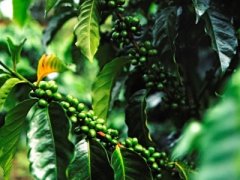The chlorogenic acid of coffee describes in detail how many ingredients are beneficial to the human body in coffee.
For professional baristas, please follow the coffee workshop (Wechat official account cafe_style)

The smell of coffee is known to relieve stress and avoid drowsiness. However, the ingredients of coffee still have a wonderful effect. This time we will introduce the chlorogenic acid in coffee.
What is chlorogenic acid?
Chlorogenic acid is a large number of ingredients in raw coffee beans. Chlorogenic acid is a kind of polyphenols. Compared with other foods, coffee beans are rich in polyphenols.
Caffeine, a healthy ingredient of coffee, has always been a concerned ingredient.
Also used for obesity and disease prevention
Chlorogenic acid is considered to be the cause of coffee, such as astringency and bitterness. In recent years, however, German pharmaceutical companies have removed a variety of efficacy associated with chlorogenic acid, which is now used as a material to prevent diabetes and obesity.
What is polyphenol?
Polyphenols are antioxidants produced by plants. Anthocyanins, catechins, such as cocoa polyphenols red wine polyphenols everyone's friends. In addition, vegetables and fruits are often included, and there are said to be more than 5000 kinds.
Polyphenols content
A cup of coffee (about 140 milliliters) contains about 280 milligrams of polyphenols, similar to red wine and about twice as much as tea. The estimated polyphenol content is 100 mg of beverage, 115 mg of green tea and 62 mg of cocoa. A daily intake of about 1500 mg of polyphenols is ideal.
In recent years, chlorogenic acid has attracted much attention in inhibiting fat accumulation and is used as a raw material for supplementary foods when on a diet.
Effect of chlorogenic acid
In recent years, studies on the effectiveness of coffee drinking in the prevention of cancer, diabetes and arteriosclerosis have been reported one after another, but the antioxidant effects of polyphenols such as green tea acid help to improve the effect.
In addition to inhibiting the antioxidation of reactive oxygen species that cause disease, inhibiting obesity, anticancer effects and other anti-obesity effects, chlorogenic acid contributes greatly to the suppression of halitosis and the recovery of fatigue.
Summary of chlorogenic Acid in Coffee Bean
It has been clarified that the "chlorogenic acid" contained in coffee beans does have a variety of effects. Coffee is considered to be a frequently heard anti-aging measure these days.
It is said that the role of chlorogenic acid will be further clarified in the future. With the progress of the research, we can go on a diet while drinking a sweet cake and coffee may not be too far.
By the way, as the roasting gets deeper, chlorogenic acid and caffeine seem to decrease. In fact, the effect of coffee may not be fully elucidated.
Important Notice :
前街咖啡 FrontStreet Coffee has moved to new addredd:
FrontStreet Coffee Address: 315,Donghua East Road,GuangZhou
Tel:020 38364473
- Prev

A brief introduction to the Flavor of Fine Coffee producing areas in Kenya comparison of flavors in different producing areas in Kenya
Professional baristas please pay attention to the coffee workshop (Wechat official account cafe_style) Kenya Coffee to the north is adjacent to Ethiopia, the origin of Arabica coffee trees, but it was not until the beginning of the 20th century that coffee cultivation began. In the 19th century, missionaries introduced Arabica trees from Yemen, but did not plant a large number of them. It was not until 1893 that Brazil's ancient bourbon coffee seeds were introduced.
- Next

What are the characteristics of rose summer coffee grown in different regions
Professional barista exchanges, please pay attention to coffee workshop (Weixin Official Accounts cafe_style) In the early years, the identification of top coffee mostly followed Japan. One king and one queen in coffee were Jamaica Blue Mountain and Hawaii Kona. However, with the continuous improvement of coffee producing countries and information sharing, we were exposed to more fine coffee, and this coffee bean Panama rose in summer became a recent year.
Related
- Beginners will see the "Coffee pull flower" guide!
- What is the difference between ice blog purified milk and ordinary milk coffee?
- Why is the Philippines the largest producer of crops in Liberia?
- For coffee extraction, should the fine powder be retained?
- How does extracted espresso fill pressed powder? How much strength does it take to press the powder?
- How to make jasmine cold extract coffee? Is the jasmine + latte good?
- Will this little toy really make the coffee taste better? How does Lily Drip affect coffee extraction?
- Will the action of slapping the filter cup also affect coffee extraction?
- What's the difference between powder-to-water ratio and powder-to-liquid ratio?
- What is the Ethiopian local species? What does it have to do with Heirloom native species?

